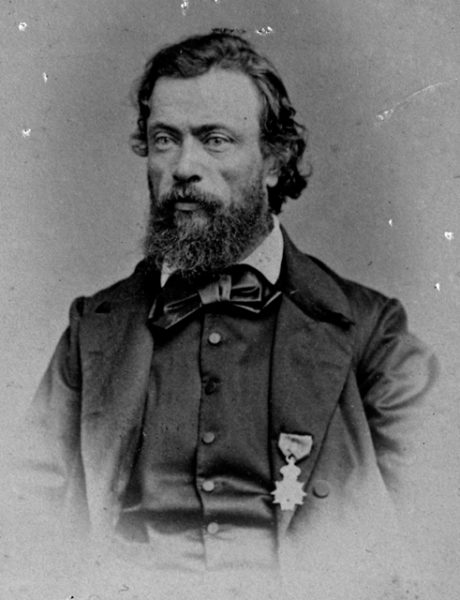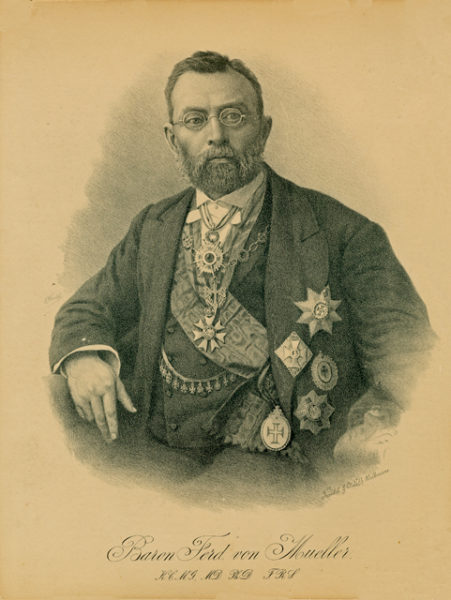By Alannah Croom
Baron Sir Ferdinand Jakob Heinrich von Mueller (1825-1896) was instrumental to the establishment and advancement of botany in Australia. Mueller was a keen inland explorer, who collected countless specimens and worked tirelessly at his craft. He produced a bounty of botanical papers, books and memoranda and, during his life-time, Mueller advanced the reputation of Victoria’s Royal Botanic Gardens exponentially, particularly in the areas of scientific and economic botany.

Mueller’s career began with a pharmacy apprenticeship in Husum, Germany, at the age of fifteen. After passing a pharmaceutical qualification, Mueller went on to study botany under Professor Nolte at the University of Kiel, and in 1847 Mueller was awarded a Ph.D. for his thesis on the Common Shepherd’s Purse (Capsella bursa-pastoris). During his studies, Mueller’s passion and knowledge of botany flourished and he spent his spare time gathering a collection of plants from Schleswig-Holstein.
In search for a warmer climate to aid both his ailing sister and himself, Mueller set off for Australia, arriving in Adelaide in December 1847. After spending a few years in the area practicing pharmacy, investigating South Australian flora and contributing papers to various organisations, Mueller moved to Melbourne in 1852. The following year, Lieutenant-Governor Charles La Trobe appointed Mueller government botanist.
Mueller threw himself into his new position and spent the proceeding three years exploring unknown areas of Victoria. His first expedition saw him investigate such locations as the Ovens River and the Buffalo Ranges, Port Albert and Wilson’s Promontory; a journey of approximately 1,500 miles. During his expedition ‘he discovered species earlier claimed to be found in Tasmania and added new genera to the flora of Australia’. Additionally, he noted the medicinal value of some plants and also reported on the suitability of areas of land in Victoria for future settlement. In November 1853 Mueller embarked on another expedition with the aim of examining the flora of the Grampians Ranges; a journey which saw him traverse 2,500 miles. Duplicates of most of the specimens and seeds Mueller collected during his travels were regularly sent back to the herbarium at the Kew Gardens in England.
In 1855 Mueller accompanied Sir Augustus Charles Gregory’s party on the North Australian Exploring Expedition. During their 5,000 mile journey, Mueller observed nearly 3000 plants, of which approximately 800 were new to Australian botany. Upon his return to Melbourne, Mueller was appointed director of the Botanic Gardens. His first task was to oversee the construction of a herbarium and it was within its stores that Mueller deposited his own extensive collection. Soon after, Mueller commenced work on Fragmenta Phytographiae Australiae, which was published between 1858 and 1882 in eleven volumes (a twelfth volume was planned, but not published).
After receiving criticism for his directorship of the gardens, Mueller was replaced by W. R. Guilfoyle in 1873. Mueller remained as government botanist and continued to lecture and publish works on Australian botany. In 1877, after a request from the Western Australian Government, Mueller surveyed the states forests and coast all the way to Shark Bay.

In addition to a scientific fascination with Victorian forests, which was developed during his numerous botanical expeditions, Mueller was also interested in the exploration of New Guinea and Antarctica. He served on the first Australian Antarctic Exploration Committee and remained very active in this area in his later years.
Mueller was a patron or working member of most scientific societies in Australia, several of which he assisted to found. He occupied a number of notable positions within such societies, including presidency of the Royal Society, the Royal Geographical Society and the Australasian Association for the Advancement of Science, as well as the vice-presidency of the Acclimatization Society. Outside of Australia, Mueller was made an honorary member of over 150 scientific societies. He was also the recipient of numerous honours and awards throughout his lifetime, including the prestigious royal medal of the Royal Society, London in 1867.
Mueller passed away on 10 October 1896 in South Yarra.
References
Deborah Tout-Smith, ‘Baron Ferdinand von Mueller, Botanist & Explorer (1825-1896), Museums Victoria Collections, 2003, accessed online November 2017.
Deirdre Morris, ‘Mueller, Sir Ferdinand Jakob Heinrich von (1825-1896)’, Australian Dictionary of Biography, National Centre of Biography, Australian National University, published first in hardcopy 1974, accessed online November 2017.
G. J. McCarthy, ‘Mueller, Ferdinand Jakob Heinrich von 1825-1896’, Encyclopaedia of Australian Science, August 2017, accessed online November 2017.
Crosbie Morrison (ed.), Melbourne’s Garden, University Press, Melbourne, 1946.
Charles Daley, Baron Sir Ferdinand Von Mueller : botanist, explorer, and geographer, H. J. Green, Government Printer, Melbourne, 1924.
Items available in the RHSV Manuscript Collection
MS 000213 (Box 068-4) Letter; McCoy, Frederick, Sir, 1817-1899
Letter signed by Frederick McCoy, to Ferdinand von Mueller, dated 1891. Letter relates to the writer’s state of health and zoological collections.



 239 A'Beckett Street Melbourne, Victoria, 3000
239 A'Beckett Street Melbourne, Victoria, 3000  03 9326 9288
03 9326 9288  office@historyvictoria.org.au
office@historyvictoria.org.au  Office & Library: Weekdays 9am-5pm
Office & Library: Weekdays 9am-5pm

